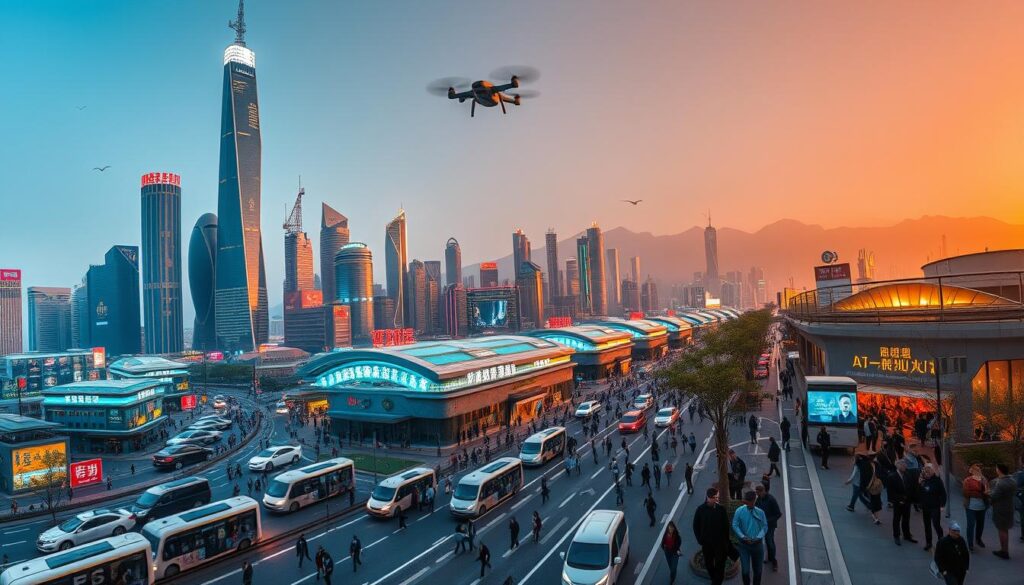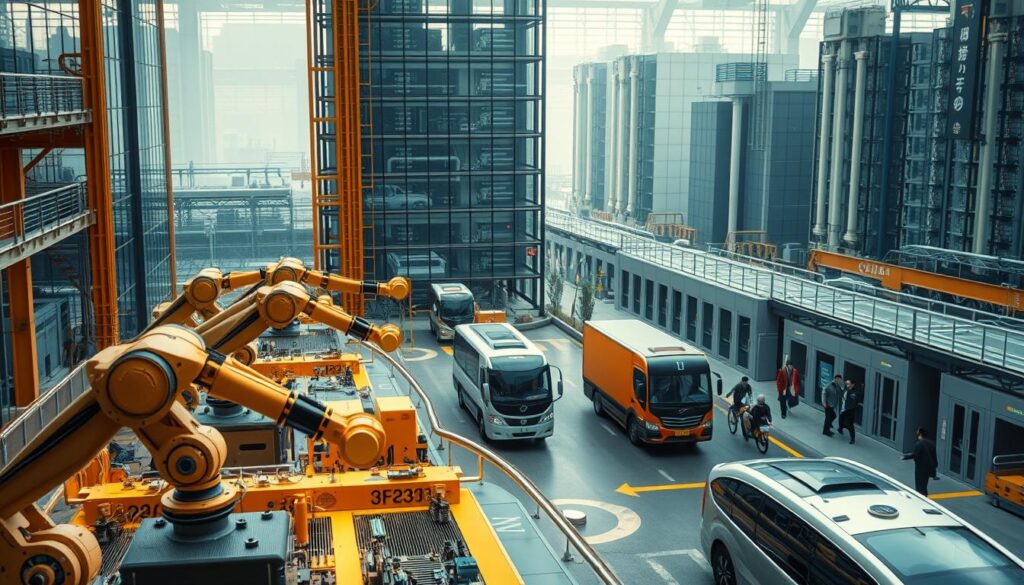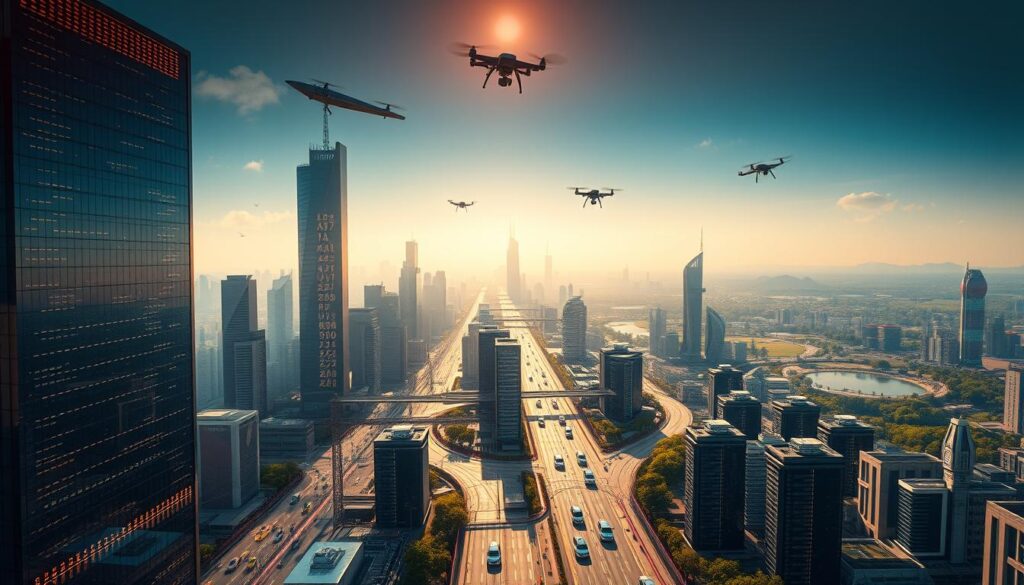“The future belongs to those who embrace innovation, even in its imperfect form.” This quote by a renowned tech visionary encapsulates China’s approach to artificial intelligence. Unlike Western methods that often seek perfection, China’s pragmatic strategy focuses on rapid adoption and real-world applications.
From Haidilao’s AI chatbot, Xiaomei, to DeepSeek’s cost-effective models, China is leveraging technology to transform industries. The government’s heavy investment in AI and a growing talent pool under 35 are driving this innovation1. This approach has positioned China as a global leader in AI development.
As the world watches, there’s much to gain from understanding China’s model. This article explores how their strategies can inspire actionable lessons for policymakers and business leaders worldwide.
Key Takeaways
- China’s pragmatic approach focuses on rapid AI adoption.
- Government investment fuels innovation in technology sectors.
- Examples like Haidilao’s chatbot showcase real-world AI applications.
- A young, talented workforce drives AI advancements.
- Cost-effective models like DeepSeek highlight efficiency.
Introduction to China’s Transformative AI Landscape

China’s journey in artificial intelligence began as a latecomer but has rapidly evolved into a global leader. Over the past decade, the country has transitioned from a follower to a front-runner, fueled by state-backed investments and academic contributions. This transformation has reshaped the global AI landscape, positioning China as a key player in the industry.
Background of China’s AI Emergence
In the early 2000s, China lagged behind in AI development. However, strategic initiatives like the Next Generation Artificial Intelligence Development Plan launched in 2017 marked a turning point. The government pledged $1.4 trillion over five years to boost AI and other high-tech sectors2. This investment spurred innovation, attracting leading companies and talent.
Academic institutions like Tsinghua University played a pivotal role. By 2024, China accounted for 26% of the world’s total computing power, with its annual data volume growing at a 26% CAGR3. These advancements laid the foundation for China’s AI dominance.
Overview of Global AI Trends
Globally, AI adoption has accelerated, but China’s approach stands out. While 54% of global respondents use generative AI, China leads with 83% adoption2. This rapid uptake reflects the country’s pragmatic focus on real-world applications.
China’s AI industry is projected to exceed $70 billion by 2025, with related sectors reaching $1.4 trillion by 20303. In contrast, global markets are heavily influenced by major tech players like the “Magnificent 7,” which shape market performance4.
| Metric | China | Global Average |
|---|---|---|
| Generative AI Usage | 83% | 54% |
| AI Industry Value (2025) | $70 billion | N/A |
| Computing Power Share (2024) | 26% | N/A |
China’s rise in AI has sparked both admiration and concern globally. Its ability to innovate at scale, supported by robust policies and a young talent pool, offers valuable lessons for other nations. For more insights into AI tools driving this transformation, explore this resource.
The Global Race in AI Innovation

The global race in artificial intelligence has intensified, with China emerging as a formidable competitor. While the U.S. historically led in translating research into products, China’s rapid growth in AI R&D has challenged the global hierarchy5. This shift has reshaped the competitive landscape, with both nations adopting distinct strategies.
The U.S. approach is methodical, focusing on precision and long-term innovation. In contrast, China prioritizes rapid deployment and practical applications. For example, DeepSeek’s R1 model, adopted by major tech companies like Tencent and Microsoft Azure AI Foundry, delivers comparable performance at a fraction of the cost5.
Key yearly milestones highlight this divergence. In 2022, ChatGPT became the fastest-growing consumer application in history6. By 2023, DeepSeek’s breakthrough marked the first time a Chinese AI model was recognized as a potential competitor to Western technologies7.
Continuous learning and iterative development are central to China’s strategy. DeepSeek’s V3 model, pre-trained using 2,048 Nvidia H800 GPUs, exemplifies this approach6. This iterative process allows for cost-effective scaling and rapid improvement.
Globally, these advancements have broader implications. The rise of cost-efficient models like DeepSeek could reduce reliance on high-end Western chips, affecting market dynamics6. For more insights into how AI is transforming industries, explore this resource.
| Metric | U.S. | China |
|---|---|---|
| AI Model Cost | High | 90-95% cheaper7 |
| Adoption Rate | Methodical | Rapid |
| Key Milestone (2023) | ChatGPT Growth | DeepSeek Breakthrough7 |
China’s pragmatic focus on real-world applications and cost efficiency offers valuable lessons for global markets. As the race continues, the balance between innovation and practicality will shape the future of AI.
Economic and Policy Strategies Driving AI in China

State-backed funding has propelled China to the forefront of AI innovation. The government’s financial interventions, including guidance funds and targeted subsidies, have created a robust ecosystem for technological growth. These strategies have not only fueled cutting-edge advancements but also ensured widespread adoption across industries.
Government Funding and Guidance Funds
China’s AI success is driven by billions of dollars in government funding. Initiatives like the Next Generation Artificial Intelligence Development Plan have allocated significant resources to research and development. Guidance funds, which pool public and private capital, have been instrumental in supporting early-stage companies8.
For example, Beijing’s initiatives have distributed funds beyond coastal regions, ensuring nationwide growth. This spatial distribution has created a competitive advantage, fostering innovation in less developed areas8.
State-Backed Subsidies and Investments
Subsidies for domestically produced AI chips have reduced reliance on foreign technology. The government’s focus on computing power has led to policies that strengthen GPU research and development8. These investments have enabled Chinese firms to advance AI technologies despite export controls8.
State-backed finances have also nurtured an ecosystem that supports startups and academic contributions. For instance, the AI Large Model “National Team” was established to enhance large-scale AI model development8.
| Strategy | Impact |
|---|---|
| Government Funding | Billions allocated to AI R&D |
| Subsidies for AI Chips | Reduced reliance on foreign technology |
| Spatial Fund Distribution | Nationwide innovation growth |
China’s economic strategies offer valuable lessons for global markets. By leveraging state-backed funding and targeted policies, the country has created a model that balances innovation and practicality. For more insights into how financial investments drive technological advancements, explore this resource.
Practical AI Applications in Chinese Industries

Artificial intelligence is reshaping industries in China, solving real-world problems with efficiency. From healthcare to hospitality, AI-driven solutions are setting new standards for operational excellence. These innovations not only save time but also reduce cost, making them a leader in practical AI adoption.
Transformations in Healthcare
In healthcare, AI is revolutionizing patient care. Wuhan Union Hospital’s AI triage service, for example, provided over 300 patients with extra consultation time in its first month. Seventy percent of these patients required urgent surgery, showcasing the system’s ability to prioritize critical cases9.
Traditional manual processes often struggle with high patient volumes. AI-driven systems, however, streamline operations, ensuring faster and more accurate care. This approach not only improves efficiency but also reduces operational costs, making healthcare more accessible9.
Innovations in Hospitality and Service
The hospitality sector is also embracing AI. Haidilao’s AI chatbot, “Xiaomei,” manages over 50,000 customer interactions daily with a 90% accuracy rate9. This system handles reservations, inquiries, and feedback, freeing up staff to focus on enhancing the dining experience.
Many Chinese hotels now use delivery robots that navigate hallways and elevators autonomously. These robots improve service efficiency, ensuring guests receive meals on time without delays9. Such innovations highlight the scalability of AI in hospitality.
| Process | Traditional Method | AI-Driven Method |
|---|---|---|
| Patient Triage | Manual prioritization | AI-based urgency assessment |
| Customer Service | Staff handling inquiries | AI chatbot managing interactions |
| Meal Delivery | Manual delivery | Autonomous robots |
China’s pragmatic approach to AI emphasizes speed and adaptability. By focusing on real-world applications, the country has become a leader in solving practical problems across industries. These advancements offer valuable lessons for global markets aiming to balance innovation and efficiency.
Embracing Imperfection: A Pragmatic Approach to AI Development

China’s approach to artificial intelligence thrives on practicality over perfection. Unlike Western methodologies that often seek flawless systems, China prioritizes rapid deployment and iterative improvements. This pragmatic mindset has fueled its rise as a global leader in cutting-edge technology.
One notable example is Haidilao’s AI chatbot, “Xiaomei.” Despite its simplicity, the system manages over 50,000 customer interactions daily with a 90% accuracy rate10. This demonstrates how functional, albeit imperfect, solutions can deliver significant value in real-world scenarios.
Another case is Wuhan Union Hospital’s AI patient service. In its first month, the system provided over 300 patients with extra consultation time, with 70% requiring urgent surgery10. Such rapid deployment highlights the benefits of adopting a “good enough” mindset in artificial intelligence development.
The risks of deploying non-flawless systems are outweighed by the rewards. Early deployment allows for faster learning and subsequent refinements. This iterative process ensures continuous improvement, making it more valuable than waiting for perfection.
| Approach | China | Western Methodologies |
|---|---|---|
| Development Focus | Rapid deployment | Precision and perfection |
| Improvement Process | Iterative refinement | Delayed perfection |
| Real-World Impact | High adaptability | Limited early adoption |
China’s agile culture in artificial intelligence offers a stark contrast to the meticulous Western methodologies. By embracing imperfection, China has created a model that balances innovation with practicality, setting a benchmark for global markets.
Learning from Setbacks: Real-World AI Adaptations

Setbacks in AI deployment have shaped China’s innovative strategies. Early challenges in the hospitality sector, for example, highlighted the need for flexible and iterative approaches. These experiences have become vital learning opportunities, driving improvements in system reliability and scalability11.
Case Study: Haidilao’s ‘Xiaomei’
Haidilao’s AI chatbot, “Xiaomei,” is a prime example of learning from setbacks. Initially, the system faced accuracy issues in handling customer interactions. However, continuous feedback and iterative updates improved its performance to a 90% accuracy rate, managing over 50,000 daily interactions11.
This case underscores the importance of adaptability in development. By embracing imperfections, Haidilao created a scalable solution that enhances customer service while reducing operational costs11.
Hybrid Models in AI Deployment
China’s hybrid AI models combine human expertise with machine efficiency. For instance, in healthcare, AI systems assist doctors in prioritizing urgent cases, improving patient outcomes. This approach balances automation with human oversight, ensuring accuracy and reliability12.
Traditional AI deployments often focus on full automation, which can lead to errors in complex scenarios. In contrast, China’s hybrid models leverage the strengths of both humans and machines, creating more robust systems12.
These adaptations offer valuable lessons for other nations. By prioritizing flexibility and iterative research, China has set a benchmark for real-world AI applications. This approach not only enhances system performance but also fosters innovation in a rapidly evolving technological landscape13.
What Can We Learn from China’s AI Success?

China’s rapid advancements in artificial intelligence offer valuable insights for global stakeholders. By focusing on practical applications and iterative improvements, the country has become a leader in AI innovation. This section highlights the key lessons that can inspire policymakers and business leaders worldwide.
One of the most significant takeaways is the emphasis on real-world applications. For instance, Haidilao’s AI chatbot, “Xiaomei,” manages over 50,000 customer interactions daily with a 90% accuracy rate9. This demonstrates how functional systems can deliver immediate value, even if they are not perfect.
Another lesson is the importance of embracing imperfections. Wuhan Union Hospital’s AI patient service provided over 300 patients with extra consultation time in its first month, with 70% requiring urgent surgery9. This rapid deployment highlights the benefits of adopting a “good enough” mindset in AI development.
China’s approach also underscores the role of researchers and academic institutions. DeepSeek, for example, employs just under 140 researchers and engineers, many of whom are fresh graduates from top Chinese universities14. This focus on cultivating domestic talent has been instrumental in driving innovation.
Here’s a summary of the key lessons:
| Lesson | Example |
|---|---|
| Real-World Applications | Haidilao’s “Xiaomei” chatbot |
| Embracing Imperfections | Wuhan Union Hospital’s AI service |
| Focus on Research | DeepSeek’s team of researchers |
These lessons challenge established norms in AI development. By prioritizing practicality and adaptability, China has created a model that balances innovation with efficiency. For more insights into AI tools driving this transformation, explore this resource.
Building a Robust AI Infrastructure: Data and Compute

China’s advancements in AI are deeply rooted in its robust infrastructure, combining data optimization and computational power. This foundation has enabled the country to scale its AI capabilities rapidly, setting a benchmark for global innovation15.
Optimizing Data Resources
Efficient data management is critical for AI success. Chinese companies have developed state-of-the-art techniques to optimize both public and private cloud resources. For example, Huawei’s “AI-in-a-box” solution integrates data storage and processing into a single, scalable unit, enhancing operational efficiency15.
These strategies ensure that data is not only accessible but also actionable. By leveraging vast data pools, China has created a competitive edge in training AI models tailored to local needs16.
Innovations in Computing Power
China’s focus on computational advancements has been equally transformative. The country has invested heavily in hardware technologies, including GPUs and TPUs, to support AI frameworks15. This investment has reduced reliance on foreign technology and fostered domestic innovation.
On-premises private cloud developments have further strengthened China’s AI infrastructure. These solutions provide secure and scalable environments for AI applications, ensuring consistent performance15.
The symbiotic relationship between data availability and computational performance has been a key driver of China’s AI success. By balancing these elements, the country has maximized the value of its AI investments16.
For those interested in leveraging AI for financial gains, explore how to make money with AI.
Revolutionizing AI Research and Development

Innovation in AI is driven by a combination of strategic planning and academic excellence. China’s focus on research and development has set new benchmarks in the global AI landscape. This section explores how trends in patents, talent development, and academic collaborations are shaping the future of AI.
Trends in AI Patents and Talent Development
China’s surge in AI-related patent filings underscores its commitment to technological leadership. By the end of 2023, Baidu had filed over 19,000 AI patent applications, with more than 9,200 patents granted17. This reflects a robust strategy to protect intellectual property while fostering innovation.
Academic institutions like Tsinghua University play a pivotal role in talent development. Collaborations between universities and industry have created a pipeline of skilled professionals. For instance, DeepSeek’s team of researchers, many of whom are fresh graduates, exemplifies this synergy18.
Generative AI models are a key focus area. ERNIE model API calls increased from 200 million in May 2024 to 1.5 billion by November 2024, showcasing rapid adoption17. This highlights the importance of scalable computing resources in supporting advanced AI frameworks.
Strategic planning in R&D has also contributed to market readiness. DeepSeek’s training process, optimized to complete in weeks instead of months, demonstrates the efficiency of iterative development18. Such advancements ensure that products are both innovative and cost-effective.
Here’s a summary of key trends:
| Trend | Impact |
|---|---|
| Patent Filings | Over 19,000 applications by Baidu17 |
| Talent Development | Collaborations with academic institutions18 |
| Generative AI Models | 1.5 billion ERNIE API calls17 |
| R&D Efficiency | DeepSeek’s optimized training process18 |
China’s approach to AI research and development offers valuable lessons for global markets. By prioritizing patents, talent, and scalable computing, the country has created a model that balances innovation with practicality. These advancements set a benchmark for future AI strategy worldwide.
Innovative Start-Ups and Academic Contributions in AI

Academic institutions in China are playing a pivotal role in shaping the future of artificial intelligence. Tsinghua University, in particular, has become a cornerstone of innovation, fostering a thriving ecosystem for AI start-ups. This collaboration between academia and industry is redefining the competitive landscape globally.
Tsinghua University’s contributions extend beyond research. It has incubated companies like Zhipu AI and Baichuan AI, which are now recognized as China’s new AI unicorns. These ventures exemplify how academic environments can drive performance and adoption in the AI sector19.
Incubating Innovation Through Start-Ups
Academic institutions provide the foundation for start-ups to thrive. Tsinghua University’s initiatives include mentorship programs, funding opportunities, and access to cutting-edge research. This support has enabled start-ups to develop scalable solutions that address real-world challenges20.
For example, Zhipu AI leverages Tsinghua’s research to create advanced AI models. These models are not only cost-effective but also deliver high performance, making them competitive in global markets19.
Collaboration Between Universities and Industry
The synergy between Tsinghua University and the tech industry has accelerated AI adoption. Companies benefit from the university’s talent pool, while students gain practical experience in leading-edge projects. This partnership ensures that innovations are quickly translated into market-ready products20.
Baichuan AI, another Tsinghua-incubated company, has developed AI solutions that are transforming industries. Its success highlights the importance of academic-industry collaboration in driving business growth19.
Here’s a summary of key contributions:
| Initiative | Impact |
|---|---|
| Mentorship Programs | Guides start-ups in scaling their operations |
| Funding Opportunities | Provides financial support for early-stage ventures |
| Research Access | Enables development of cutting-edge AI models |
China’s academic institutions are not just centers of learning but also engines of innovation. By fostering start-ups and collaborating with industry, they are setting new standards in AI performance and adoption. These efforts are reshaping the global AI landscape, offering valuable lessons for other nations.
The Rise of Open-Source AI Models and Market Disruptions

Open-source AI models are reshaping the tech landscape, challenging traditional proprietary systems. These initiatives are not only democratizing access to advanced technologies but also disrupting long-standing market dynamics. Companies like DeepSeek are at the forefront of this transformation, offering high-performance solutions at a fraction of the cost.
DeepSeek and the Cost Debate
DeepSeek’s breakthrough in delivering high-performance AI models at dramatically lower costs has sparked a global debate. Their latest model, DeepSeek R1, reportedly cost less than $6 million to develop, a stark contrast to the billions spent by Western counterparts21. This cost efficiency has positioned DeepSeek as a disruptive force in the AI industry.
The company’s focus on recruiting domestic talent, primarily fresh graduates from top Chinese universities, has further reduced operational expenses. With salaries significantly lower than those in the U.S., DeepSeek has managed to maintain high performance while minimizing costs21.
Market reactions to DeepSeek’s innovations have been mixed. While some investors view open-source models as a threat to traditional proprietary systems, others see them as an opportunity for broader adoption. The Nasdaq’s performance, up approximately 25% for the year, reflects this shifting sentiment22.
However, the rapid adoption of open-source AI platforms comes with its own set of risks. Security concerns and the sustainability of national advantages in AI technology are hotly debated. As DeepSeek continues to innovate, the industry must address these challenges to ensure long-term success22.
Lower-cost development cycles are also challenging conventional wisdom on AI R&D investments. DeepSeek’s iterative approach, which focuses on rapid deployment and continuous improvement, has proven that high-quality AI models can be developed without exorbitant budgets21.
For more insights into how open-source AI is transforming industries, explore this resource.
Security and Geopolitical Considerations in AI Growth

The rapid growth of AI technology has brought both opportunities and challenges in the field of security and geopolitics. As nations race to develop advanced systems, vulnerabilities in AI infrastructure have become a pressing concern. These risks are not just technical but also geopolitical, shaping international policies and strategies23.
One of the most significant challenges is the dual-use nature of AI technologies. For example, reinforcement learning from human feedback (RLHF) can train systems to adhere to supportive or opposing values, depending on the intent23. This duality raises questions about how to balance innovation with security in the field.
Geopolitical tensions have further complicated the landscape. The U.S. has imposed export controls to limit China’s access to advanced computing power, but these measures have proven ineffective. DeepSeek, a Chinese AI startup, has achieved comparable capabilities with significantly lower investments, challenging traditional dominance24.
Security flaws in deployed AI models have also sparked international scrutiny. For instance, Italy banned DeepSeek due to data-transfer issues, while Belgium and Ireland initiated investigations into its data protection practices24. These incidents highlight the risks of rapid AI adoption without robust safeguards.
Chinese companies are navigating these challenges by prioritizing compliance with national security rules. For example, AI outputs must avoid criticism of the Chinese regime, ensuring alignment with state policies24. This approach allows them to push technological boundaries while managing security risks.
The interplay between innovation and security has broader implications for international policy. The U.S. AI Safety Institute (AISI) focuses on promoting AI safety, but the lack of engagement with China has impeded cooperation23. Historical precedents, like Cold War-era cooperation on permissive action links (PALs), suggest potential avenues for collaboration23.
Here’s a summary of key considerations:
| Challenge | Impact |
|---|---|
| Dual-Use Technologies | Balancing innovation with security risks |
| Export Controls | Ineffective in limiting China’s AI advancements |
| Security Flaws | International bans and investigations |
| National Compliance | Chinese AI aligns with state policies |
As the nations continue to compete in AI development, addressing these challenges will be crucial. Balancing innovation with security will shape the future of the field, influencing both technological progress and global stability23.
Impact of Financial Investments on AI Innovation

Financial investments have become the backbone of AI innovation, driving rapid advancements and reshaping global markets. The economy of AI development relies heavily on funding, with venture capital and state-backed funds playing pivotal roles. This section explores how these financial landscapes accelerate AI growth and the implications for the global economy.
Venture Capital Dynamics in AI
Venture capital (VC) has been a key driver of AI innovation, particularly in the United States. However, China’s approach to VC funding differs significantly. While U.S. investors focus on high-risk, high-reward startups, China’s state-backed funds often fill investment gaps, ensuring steady growth in the AI sector25.
For example, the development cost of DeepSeek’s V3 model was estimated at $5 to $6 million, a fraction of the billions spent by Western counterparts25. This cost efficiency highlights the strategic advantage of China’s investment model, which prioritizes scalability and affordability.
State-Backed Funds and Economic Outcomes
China’s state-backed funds have been instrumental in bridging the gap between innovation and market readiness. These funds provide not only financial support but also strategic guidance, enabling startups to navigate complex problems and scale their operations25.
Aggressive investment strategies, however, come with risks. The AI market is projected to grow to $1 trillion by 2027, but the return on investment remains uncertain26. This uncertainty underscores the need for balanced approaches that mitigate risks while fostering innovation.
High-Profile Investment Cases
Several high-profile investments have propelled AI startups to unicorn status. Companies like DeepSeek and Baichuan AI have benefited from both VC and state-backed funding, achieving remarkable success in a competitive market25. These cases illustrate the transformative power of strategic financial investments in the AI sector.
| Investment Source | Impact |
|---|---|
| Venture Capital | High-risk, high-reward startups |
| State-Backed Funds | Steady growth and scalability |
| Aggressive Strategies | Uncertain returns and market volatility |
The long-term economic implications of these investments are profound. As AI continues to evolve, the global economy will be shaped by the ability of nations to balance innovation with financial sustainability. This dynamic presents both opportunities and challenges for policymakers and investors alike.
Navigating Regulatory and Policy Frameworks for AI
Regulatory frameworks play a critical role in shaping the trajectory of artificial intelligence development globally. In the United States and China, differing approaches to regulation have created unique challenges and opportunities for innovators. These frameworks not only influence the pace of tech advancements but also determine the competitive dynamics between nations.
US Export Controls and Their Implications
U.S. export controls on advanced tech have aimed to limit China’s access to critical components like GPUs and TPUs. However, these measures have had unintended consequences. Instead of stifling innovation, they have spurred China to invest heavily in domestic science and technology, accelerating self-reliance27.
For example, DeepSeek, a Chinese AI startup, developed high-performance models at a fraction of the cost of Western counterparts. This achievement highlights how regulatory barriers can drive innovation rather than hinder it27.
In contrast, the U.S. approach focuses on protecting intellectual property and maintaining a competitive edge. While this strategy has yielded significant results, it has also created a fragmented global market28.
Spurring Domestic Innovation in China
China’s response to U.S. export controls has been transformative. The country has implemented policies like the Next Generation Artificial Intelligence Development Plan, which allocates billions to AI research and development27. This investment has fostered a robust ecosystem of startups and academic collaborations.
Generative AI service providers in China are now required to undergo comprehensive security assessments and disclose their algorithms. These measures ensure transparency and fairness, setting a new standard for tech regulation29.
Contrasting Scientific and Technological Results
The differing regulatory approaches have led to distinct outcomes. In the U.S., the focus on precision and long-term innovation has produced cutting-edge tech but at a higher cost. In China, the emphasis on rapid deployment and practicality has resulted in cost-effective solutions that are widely adopted28.
For instance, China’s AI industry is projected to exceed $70 billion by 2025, driven by policies that encourage experimentation and scalability27. This growth contrasts with the U.S., where regulatory hurdles can slow down innovation.
| Metric | United States | China |
|---|---|---|
| Regulatory Focus | Intellectual Property Protection | Rapid Deployment and Scalability |
| AI Industry Value (2025) | N/A | $70 billion27 |
| Key Policy | Export Controls | Next Generation AI Plan27 |
Strategic policy adjustments are essential to support long-term innovation. By balancing regulation with flexibility, nations can foster a competitive yet collaborative global AI landscape. These efforts will ensure that science and tech continue to drive progress while addressing ethical and security concerns29.
Future Trends in AI: Cost Reduction, Performance, and Global Leadership
The evolution of artificial intelligence is entering a transformative phase, driven by cost efficiency and performance breakthroughs. As industries worldwide adopt AI, the focus is shifting toward making these technologies more accessible and scalable. This section explores the anticipated trends that will shape the future of AI, from reducing development costs to enhancing global leadership.
Accelerating Innovation Cycles
One of the most significant trends is the acceleration of innovation cycles. Companies like DeepSeek have demonstrated that high-performance AI models can be developed at a fraction of traditional costs. For instance, DeepSeek’s R1 model was developed for less than $6 million, a stark contrast to the billions spent by Western counterparts30.
This cost efficiency is reshaping the reality of AI development. By focusing on iterative improvements and rapid deployment, organizations can achieve faster results without compromising quality. This approach not only reduces expenses but also allows for quicker adaptation to market demands30.
The Jevons Paradox in AI Adoption
The Jevons Paradox, which states that increased efficiency leads to higher consumption, is particularly relevant in AI. As AI technologies become more cost-effective, their adoption is expected to surge. This paradox highlights the need for sustainable strategies to manage the increased energy consumption associated with widespread AI use9.
For example, Chinese hotels have successfully integrated delivery robots that operate autonomously, enhancing guest services without significant disruption9. This trend underscores the importance of balancing efficiency with environmental considerations.
Historical data also supports this trend. In 2016, Haidilao’s AI system “Xiaomei” managed over 50,000 customer interactions daily with a 90% accuracy rate9. Such advancements demonstrate how cost reduction and performance improvements can coexist, driving broader adoption.
| Trend | Impact |
|---|---|
| Cost Reduction | DeepSeek’s R1 model developed for under $6 million30 |
| Performance Improvements | Haidilao’s “Xiaomei” achieves 90% accuracy9 |
| Energy Consumption | Jevons Paradox highlights sustainability challenges9 |
Looking ahead, the global AI landscape will be shaped by these trends. Policymakers and businesses must prioritize cost efficiency, performance, and sustainability to stay competitive. For more insights into AI tools driving this transformation, explore this resource.
Conclusion
The pragmatic strategies behind China’s AI advancements offer valuable lessons for global innovation. By prioritizing rapid deployment and iterative improvements, China has demonstrated how flexibility and adaptability drive success in technology adoption. For instance, DeepSeek’s cost-efficient models, comparable to Western counterparts, highlight the benefits of focusing on practical applications over perfection22.
Key examples like Baidu’s ERNIE Bot, which supports over 85,000 enterprises, showcase the scalability of AI solutions in real-world scenarios31. This approach underscores the importance of balancing innovation with immediate impact, a strategy that can inform future AI policies and business strategies worldwide.
For U.S. policymakers and leaders, embracing a risk-tolerant mindset is crucial. Lessons from China’s AI journey emphasize the need for continuous adaptation and strategic investments. To explore more about China’s success in artificial intelligence, consider how these insights can shape a more dynamic and competitive AI landscape.
FAQ
How has China’s government supported AI development?
What industries in China are benefiting from AI applications?
What role does data play in China’s AI success?
How does China approach AI innovation compared to other countries?
What are the challenges in China’s AI growth?
How do Chinese universities contribute to AI research?
What are the future trends in AI development globally?
How does China’s AI strategy impact global competition?
What lessons can other countries learn from China’s AI success?
Source Links
- DeepSeek: How China’s ‘AI heroes’ overcame US curbs to stun Silicon Valley
- China’s AI Surge Could Impact the Global Business Landscape, Experts Say | PYMNTS.com
- China’s AI Advancements: Market Implications and Investment Considerations
- China’s AI Breakthrough Signals a New Era of Tech Innovation
- China’s AI Breakthrough and the Global Race for Artificial Intelligence Supremacy
- China Upends the AI Race
- China’s AI development model in an era of technological deglobalization
- Three lessons the west can learn from China’s economic approach to AI
- What the West can learn from China about using AI – Asia Times
- China Is Rapidly Becoming a Leading Innovator in Advanced Industries
- Challenges with developing and deploying AI models and applications in industrial systems – Discover Artificial Intelligence
- Superagency in the workplace: Empowering people to unlock AI’s full potential
- China celebrates DeepSeek’s breakout AI success as tech race heats up | CNN
- A Policy Blueprint for US Investment in AI Talent and Infrastructure | Andreessen Horowitz
- The AI Superpower Showdown
- Revolutionizing with AI: Learn from Baidu’s Journey
- DeepSeek: Revolutionizing AI Development and Reshaping Global Tech Competition
- DeepSeek: how China’s embrace of open-source AI caused a geopolitical earthquake
- China’s DeepSeek and its Open-Source AI Models
- China celebrates DeepSeek’s breakout AI success as tech race heats up | CNN
- Some simple lessons from China’s big AI breakthrough
- How Might the United States Engage with China on AI Security Without Diffusing Technology?
- The geopolitics of artificial intelligence after DeepSeek
- How DeepSeek-V3 Could Reshape AI and Tech Markets | Coface
- AI’s Stock Market Impact: What You Need to Know
- AI Watch: Global regulatory tracker – China | White & Case LLP
- The Evolving AI Regulatory Landscape in Asia: What Compliance Leaders Need to Know
- Balancing Innovation and Regulation: Comparing China’s AI Regulations with the EU AI Act
- Gen AI Can Help Retailers Defy China’s Economic Slowdown
- China’s Generative AI Ecosystem in 2024: Rising Investment and Expectations







